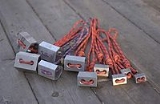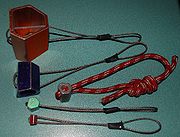
Hexcentric
Encyclopedia

Climbing equipment
A wide range of equipment is used during rock climbing. The most popular types of climbing equipment are briefly described in this article. The article on protecting a climb describes equipment commonly used to protect a climber against the consequences of a fall....
used to protect climbers from injury during a fall. They are intended to be wedged by into a crack or other opening in the rock, and do not require a hammer to place. They were developed as an alternative to pitons
Piton
In climbing, a piton is a metal spike that is driven into a crack or seam in the rock with a hammer, and which acts as an anchor to protect the climber against the consequences of a fall, or to assist progress in aid climbing...
, which are hammered into cracks and are more prone to damage the rock. Most commonly, a carabiner
Carabiner
A carabiner or karabiner is a metal loop with a sprung or screwed gate that is used to quickly and reversibly connect components in safety-critical systems. The word comes from "Karabinerhaken", meaning "hook for a carbine" in German.-Use:...
will be used to join the hex to the climbing rope by means of a loop of webbing, cord or a cable which is part of the hex.
Hexes are a type of nut
Nut (climbing)
In rock climbing, a nut is a metal wedge threaded on a wire, used for protection by wedging it into a crack in the rock. Quickdraws are clipped to the nut wire by the ascending climber and the rope threads through the quickdraw. Nuts come in a variety of sizes and styles, and several different...
, a hollow eccentric hexagonal prism with tapered ends, usually threaded with webbing
Webbing
Webbing is a strong fabric woven as a flat strip or tube of varying width and fibres often used in place of rope. The name webbing comes from the meshed material frequently used in its construction, which resembles a web...
, a swaged cable, or a cord. They are manufactured by several firms, with a range of sizes varying from about 10 mm thick to 100 mm wide. Climbers select a range of sizes to use on a specific climb based on the characteristics of the cracks in the rock encountered on that particular climb. Sides may be straight or curved although the functioning principles remain the same no matter which shape is selected; the lack of sharp corners on curved models may make them easier to remove from the rock.
Hexes may be placed either as passive or active protection. When placed passively they work like chock stones in flared cracks, like other climbing nuts, just larger and with a different shape. Active protection is achieved by orienting the webbing so that a pull causes a camming action against the rock similar to Tricams, allowing for placement in parallel cracks. They are often preferred by alpine mountaineers over spring-loaded camming devices because of their lack of moving parts and overall lower weight for the same size crack.
The original Hexes were invented by Yvon Chouinard
Yvon Chouinard
Yvon Chouinard is a rock climber, environmentalist and outdoor industry businessman, noted for his contributions to climbing, climbing equipment and the outdoor gear business. His second company, Patagonia is known for its environmental focus...
and Tom Frost
Tom Frost
Tom Frost is a rock climber from California, best known for big wall climbing first ascents in Yosemite Valley. He is also a photographer and climbing equipment manufacturer.-Rock climbing and mountaineering:...
, and called Hexentrics. They applied for a U. S. patent in 1974 and it was granted on April 6, 1976, and they were produced by Chouinard Equipment, Ltd until 1989, then sold as a design to Black Diamond Equipment. Hexentrics are produced and sold in much the same design today.

